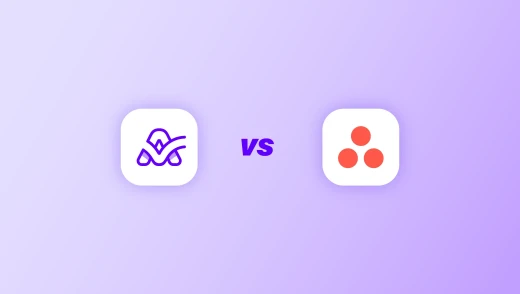So you’re a service business looking for a project management solution, and you're stuck. You’ve shortlisted a few, and you’ve come down to ActiveCollab or Asana.
Both start with the letter “A”. Both are a project management software. Both have a neat and uncomplicated UI. People usually use both to manage projects. But they offer different core features and setup options.
So which one will it be? To help you make that decision, we’ll take you through what each one has to offer when it comes to the most sought-after capabilities service business founders look for in a project management tool.
What makes ActiveCollab a top tool for service businesses
The main reason service businesses gravitate towards ActiveCollab is that it’s designed with their workflows in mind.
Before we get into the things that make ActiveCollab a top choice for service businesses, instead of comparing project management features (that are mostly a standard these days), here’s how the two tools compare with respect to some key decision-makers for buyers.
| Key decision-makers | ActiveCollab | Asana |
|---|---|---|
| Setup & onboarding | Create projects instantly, intuitive design with a minimal learning curve for new users | Simple to start for tasks, but advanced features (such as Portfolio/Workload) require setup |
| End-to-end client project management | Keeps the entire workflow in the platform, from quote to project work to invoice | Requires third-party integrations for budgets, and invoicing |
| Collaboration (internal + external) | Unlimited internal & external collaboration, multiple access permission levels | External collaboration is only available in the Organization setup, not Workspace |
| Workload management | Instant workload views, drag-and-drop rescheduling & capacity planning | Workload available, but needs to be tied to Portfolios, and effort value needs to be manually set |
| Dashboards & reporting | Built-in, easy-to-use real-time dashboards for profitability, team & time insights | Strong project dashboard focused on productivity metrics, financials require integrations |
| Ideal users | Agencies & consultancies managing multiple clients & projects | Has a broad business application, doesn’t cater exclusively to one business segment |
| Value for money | You get more for your money: a broad mix of functionality for one package deal, minus the setup complexity | Higher per-user cost if you need the paid plan, and consider the cost of adding third-party apps if needed |
Instead of giving you a base project management tool where you can stitch together multiple solutions like Asana does, ActiveCollab rolls all these up into one connected system from the start.
You get time tracking, budgeting, invoicing, client collaboration, team management, and business reporting from the onset.

Why is this important?
Because it gives your agency a centralized and streamlined workflow and a complete picture of both project delivery and financial health without app-switching.
It's much more than just a software with project management capabilities!
From the minute you scope a client project, ActiveCollab lets you set budgets, assign tasks, and plan workloads against your team’s capacity. As your team works, every tracked billable and non-billable hour feeds into your project financials and timesheets and you track financial segment of project progress.
And when your project is done, you can generate a branded invoice directly from the completed tasks and timesheets and send it off to your clients. On receipt, your clients can make online payments through integrated gateways, and ActiveCollab will log the payment collection.
Client collaboration is also a given with ActiveCollab. You can invite an unlimited number of clients and choose between basic and advanced permissions to tailor the level of interaction and transparency you’d like to have on client projects.
This combination of operational efficiency, financial clarity, and client collaboration in one single platform is what places ActiveCollab above traditional project management tools like Asana.
Client collaboration is a given in ActiveCollab; Asana limits it to organizations
While both tools offer features that allow external collaboration with members outside your team, Asana only makes them available on a particular account set up.
ActiveCollab, on the other hand, assumes every account and plan type will use the feature. That’s why the tool is already set up to allow client access from the get-go. Offering an unlimited number of clients, you can choose between two client roles, which offer different levels of permissions:
- Client Role (free): Gives clients basic access to invited projects where they can view tasks, create & edit discussions and notes, and add files via comments.
- Client+ role (paid): Offers more permissions and visibility where invited clients can create, edit, and manage tasks, own tasks, view budget details, and task assignees.
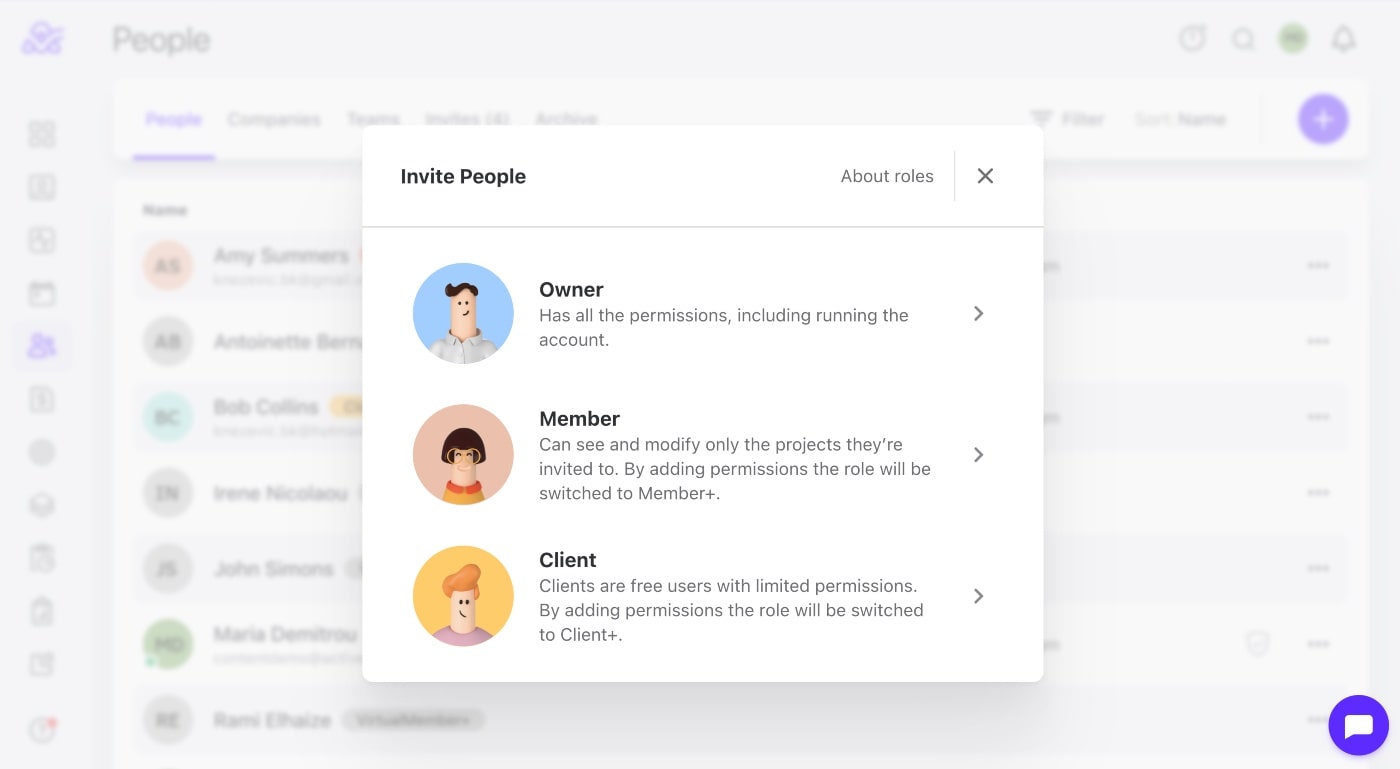
Whether it’s a matter of sharing work with clients to get feedback or approvals, ActiveCollab’s platform lets you centralize client work collaboration for both internal and external stakeholders. The beauty of the platform is the balance it provides in flexibility and control.
The “Hide from clients” checkbox is a neat little task feature that always keeps the access permission reins in your hands. By selecting it, you keep certain conversations for internal eyes only. This kind of setup gives you a workspace that lets both parties function as an extension of one another’s team, which is what most service businesses (particularly creative agencies) need.

Asana takes a different approach. Instead of “clients,” they have “guests”. However, if you want to add guests to your projects (even to multiple projects), you first need to make sure your account is set up as an “Organization” because the guest feature is not available if you are set up as a “Workspace”.
ActiveCollab is built for workload & capacity planning; Asana needs to be configured
Workload management and capacity planning are among the biggest sore spots for service businesses.
Why?
Because it’s difficult to get a real-time grasp on current and future workloads, you can balance resource utilization.
Here again, both tools offer solutions, but at different levels.
ActiveCollab goes full circle by letting you do workload management as well as capacity planning. The moment you set each employee’s capacity (which you can customize based on daily work hours), the platform’s Workload feature lets you see:
- The tasks everyone is working on
- Each individual’s logged and available hours
- If they are overbooked and at risk of burnout
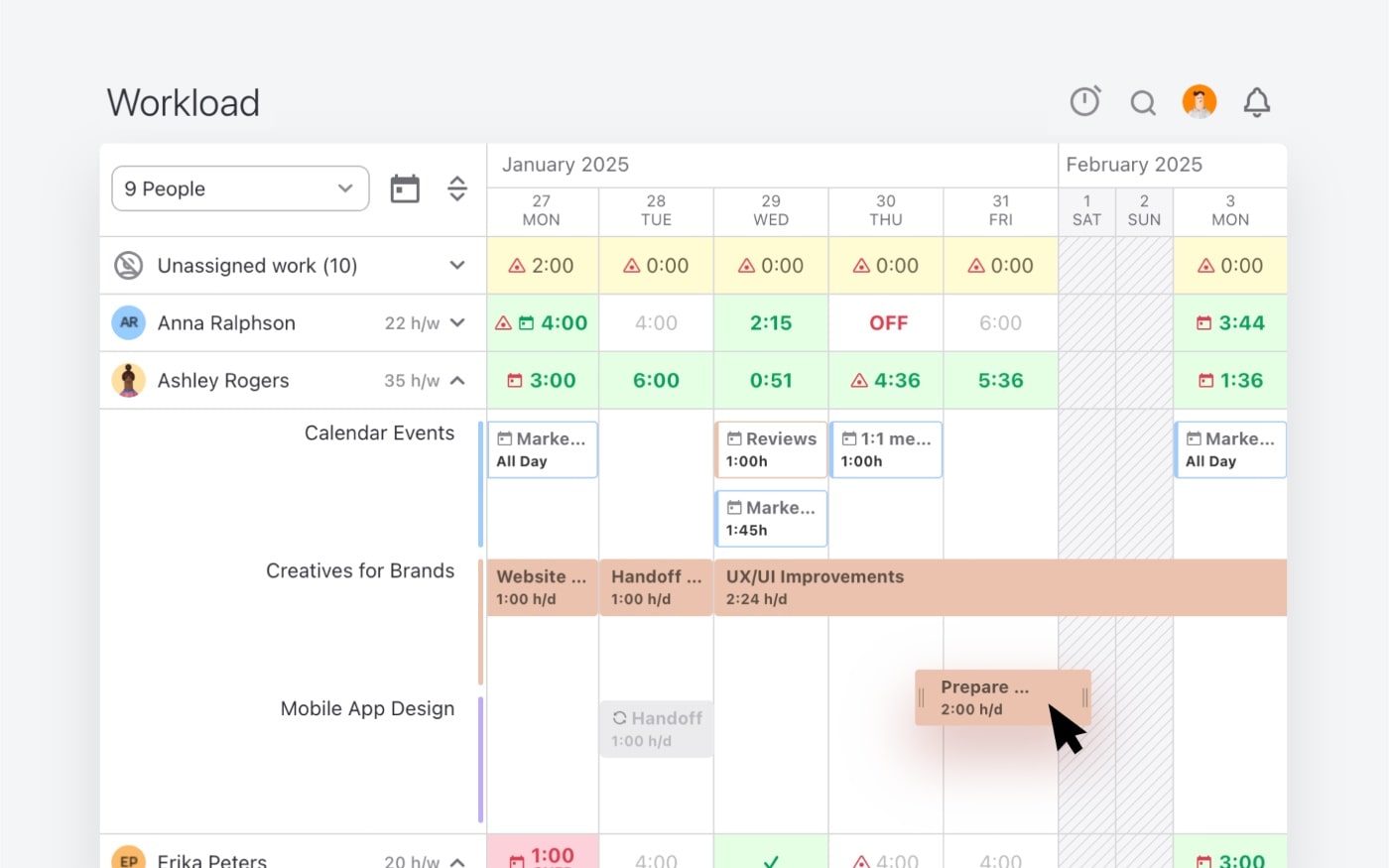
When you see that workloads are out of balance, you can use the drag and drop feature to reassign or reschedule tasks.
ActiveCollab simplifies people and project management by blending workload with billable utilization, time and project tracking, and profitability to give agencies a clear picture of their business capacity. Not only does it show you when the team is at risk of burnout, and who has time on their hands, it also lets you take actions immediately to balance task allocation and stay within budget.

With Asana, you also have the Workload view, where you can see assigned tasks across projects. However, Asana uses effort values (hours or points) to measure and track capacity, which you need to set manually. Its Workload feature is also tied to Portfolios, so you must create and maintain portfolios for the data to show. While it shows workload distribution, it doesn’t come with built-in billable utilization metrics.
ActiveCollab connects core functions; Asana prioritizes work coordination
Task management, time tracking, budgeting, and invoicing are all interdependent.
So, ideally, you want a tool that integrates these core functions and creates a perfect flow of information where each one feeds into the next.
This is where the two tools differ again. While ActiveCollab is determined to give users access to a full financial workflow, Asana remains focused on prioritizing task coordination.
ActiveCollab is different in the sense that it offers a full-cycle client management solution that connects all the time and money dots within its own platform.
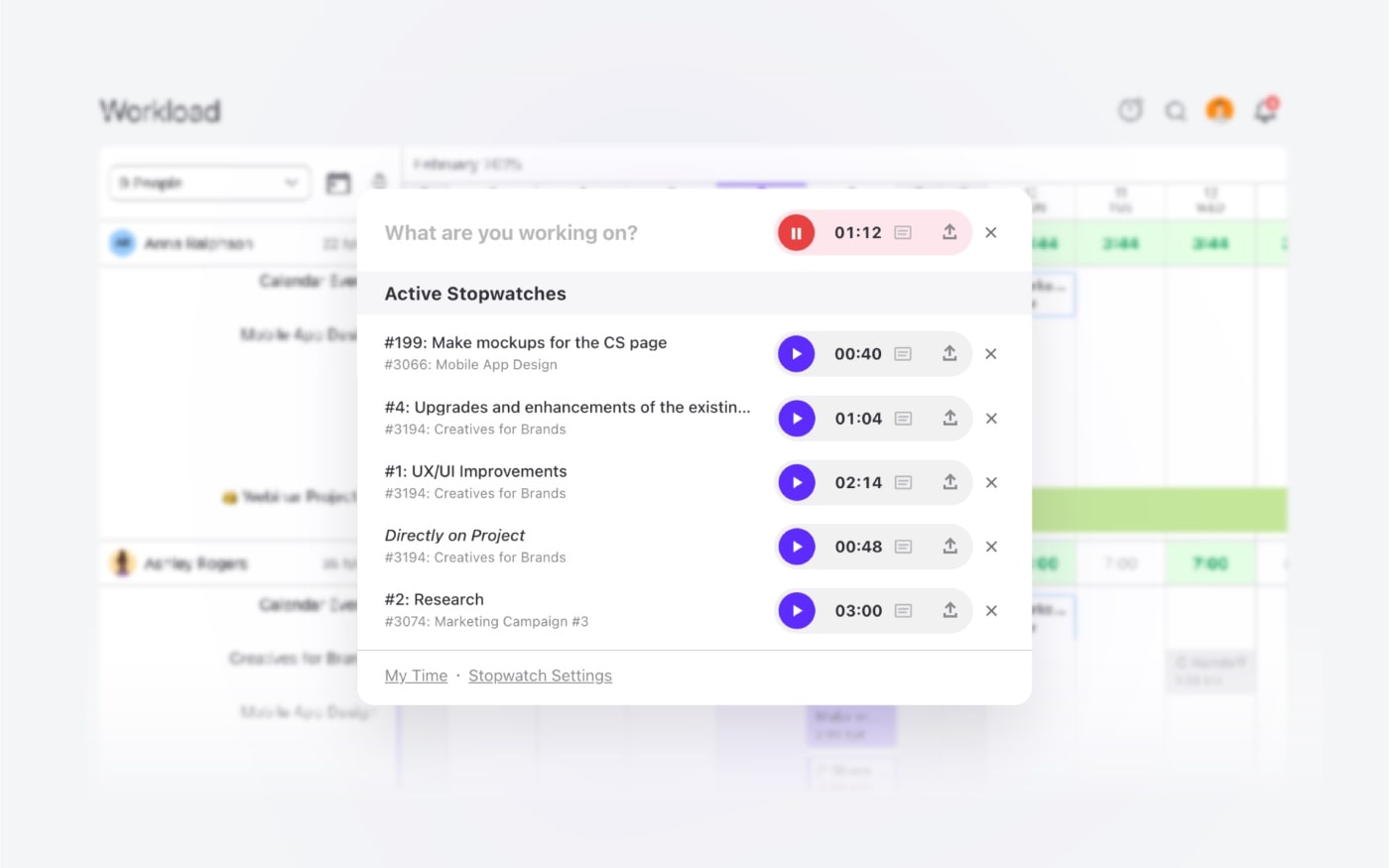
The built-in time tracker lets you track task time or log it manually for billable and unbillable tasks. All the tracked time connects directly to project tasks, people, and invoices. You can then use all that data to generate branded invoices (including e-invoices) to send directly to your clients. And then ActiveCollab goes a step further by offering online payments via:
- PayPal payments
- Credit cards (via PayPal Payflow Pro, Authorize.Net, Stripe & Braintree

Asana, at its core, is a platform that excels in work coordination and task management.
It ensures tasks are assigned, tracked, and completed on schedule, but it doesn’t delve into financial tracking as a ready-made app. Without native features for project budgets, billable utilization, and profitability, the only way you can get this kind of insight is through third-party integrations.
ActiveCollab puts business intelligence on a pedestal; Asana focuses on project metrics
For service businesses, understanding whether or not their complex projects are profitable and agency operations are sustainable is vital. But getting that information on key agency health metrics isn’t always easy.
Both ActiveCollab and Asana offer business insights through dashboards and reports, but they focus on two different levels.
ActiveCollab takes a holistic approach by combining operational reporting with financial insights.

If you’re keen to get your hands on financial data, you’ll like ActiveCollab. It lets you generate customizable and filterable reports across all areas of business. From overdue invoices, to most profitable projects, and team workloads and utilization rates.
By using the tool’s Overview dashboard, you can monitor progress across several productivity and profitability metrics, where you can see:
- Task completions (total open and completed tasks)
- Tracked time (billable and unbillable breakdown)
- Budget spend (where you can set budget alerts)
- Expense breakdown (billable & unbillable)
- Profitability (total income, cost, and profit)
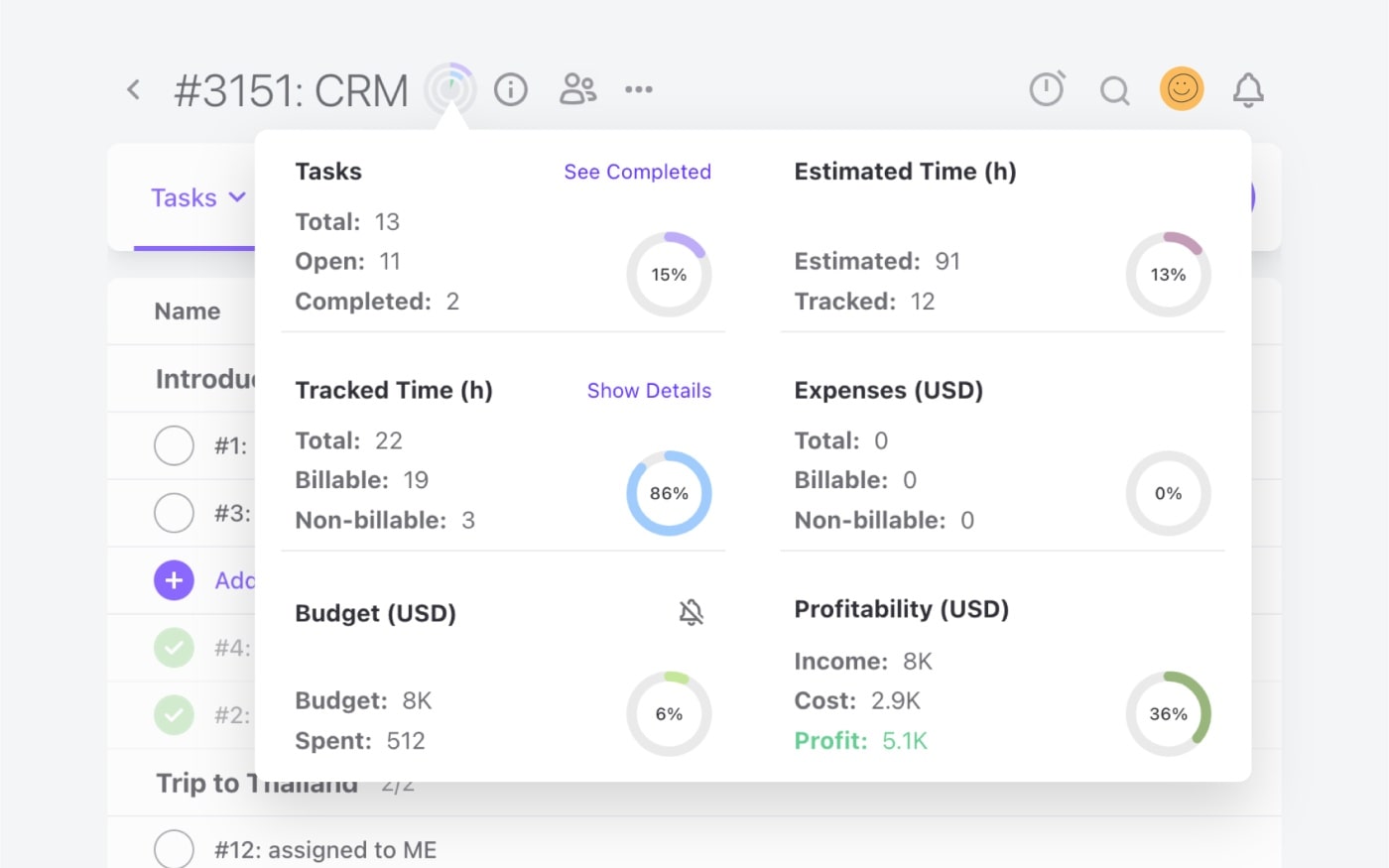
Because all the data lives in one system, agencies get real-time visibility on how they are delivering work and if their customer profitability is within a healthy margin.
With Asana, the focus shifts to project data on task progress and productivity. Its Universal Reporting dashboard lets you create charts, graphs, and dashboards on task status, assignee workloads, and other custom fields you create. However, it doesn’t have set financial and profitability metrics, unless you manually create them or feed them in through a third-party tool.
ActiveCollab vs. Asana: Which one is easier to use?
If a key decision-maker for you is tool usability and team adoption, you’ll do just fine with both, as neither is complex, and both are relatively beginner-friendly apps.
ActiveCollab, with its intuitive interface and advanced features, is straightforward, functional, and easy to get the hang of. Because it offers more features than Asana, it’s a little more advanced and comes with more menu components. So while it may take a little more time to learn, the payoff will be in the wider scope of functionality and insights your business experiences as a result.
With Asana’s sleek UI and clean design, many users find Asana easy to get started with. However, some user reviews point to the fact that while the tool is not overwhelming, it might not offer enough advanced features for projects that require budget tracking.
One thing that does need to be mentioned is that ActiveCollab has combined the essential features of multiple products vital for service businesses and rolled them up into one neat platform. Without overwhelming users, it’s struck a nice balance between power and usability.
When you look at price and value, which is better?
The strengths and the solutions the two tools offer differ drastically. They also target two different types of customers. And this is evident in the pricing.
ActiveCollab provides a stronger return on investment for agency and consultancy businesses, particularly if your teams are in the small to medium size range.
Wrapping up project management, agency management, and client management into one platform, you get all the core functions, including financials, as native features.
Asana gives you an excellent base platform that larger teams might find more appealing because they can mix and match third-party tools to build out their own system.
While pricier for the high-end plans, where features such as workload management are available, it does offer some strong project management and workflow management features.
If you put pen to paper to work out which tool gives you more value for the price, here’s what you’ll find:
ActiveCollab gives you immediate access to more functions on all its paid plans, such as project management, time tracking, financials, client collaboration and communication, and capacity planning.
Asana gives you basic project management on its freemium account for up to 10 people, where you can connect with over 100 apps.
In the end, it all comes down to your workflows and the capabilities you are after: Do you want an all-in-one or are you more of an a la carte kind of operation?
ActiveCollab: Tailored for service business workflows
ActiveCollab is designed for service businesses and service business industry in general. From client estimate to project management, delivery, invoice, payment, and profitability reporting, the tool covers the entire workflow in one platform.
It’s been formulated to centralize all the business operations agencies, consultancies, and software development shops need in client services.
On top of that, it gives you flexibility and control when it comes to client collaboration. You choose how deeply you want to interact with your clients on their projects and how much access they have to the tasks related to their deliverables.
Because time tracking is natively tied to tasks and budgets, invoice generation is almost instantaneous, and online payments are easy. With workload management features, your managers can balance work across the team and prevent utilization risks, whether they be profit churners or burnout.
ActiveCollab gives agency founders complete transparency and control over their entire team and client operations. Because everything is connected, it’s easier to keep on top of multiple clients, projects, and deadlines.
While Asana can be a top choice for a variety of business project types, ActiveCollab shines for service teams.
Want to run your entire business through a single system? Sign up for ActiveCollab’s 14-day trial or book a demo with one of our people to check out the platform live!
